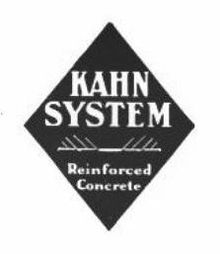Kahn System

Trademark
|
|
| Process type | Physical |
|---|---|
| Industrial sector(s) | Structural engineering |
| Main technologies or sub-processes | Reinforced concrete |
| Feedstock | Concrete and steel |
| Inventor | Julius Kahn |
| Year of invention | c. 1900 |
| Developer(s) | Trussed Concrete Steel Company |
The Kahn System is an industrial construction technique for reinforcement of buildings that was engineered and patented by Julius Kahn. The Kahn system is an industrial construction design using the Kahn Trussed Bar as the bases. This steel bar was a new type of reinforcing bar used in concrete and had unique engineered features to distribute stress.
Kahn saw problems with the concrete reinforcement systems used in building construction at the end of the nineteenth century. The existing technique of construction of the time was using concrete with a plain straight steel in the center of a concrete beam. The steel in the concrete would slip if there was even the tiniest bit of room between the hardened concrete and the steel and it would break adhesion. The main reinforcing bar had plain steel beam members rigidly attached to it. This diagonal tension fractured the reinforcing bar beams since the adhesion was broken. This caused weakness in the concrete/steel reinforced beam and a failure that could cause catastrophic results. The problem was that the plain steel beam separated from the concrete causing a failure since the two materials were no longer working together for strength.
A reinforced beam bar in the early 1900s consisted of a plain straight steel in the center of a molded concrete form. The beam would fail along the lines of principal stresses in the concrete through shearing. The plain straight steel was placed into an encased mold and concrete was poured in. This formulated mixture of steel and concrete then hardened and became the reinforced beam bar. However, in some cases there was a tiny air gap between the steel and the hardened concrete which allowed the steel to move and slip. This weakened the reinforced beam from its original full strength capability. This meant then this weakened fractured beam could fail and break under the heavy load of the building it was supporting.
Kahn discovered that concrete was much stronger in compression than tension, so came up with the idea of distributing the stresses. He did scientific engineering experiments and came up with the concept that if the steel beam edges were bent back at a 45 degree angle forming projecting tabs or "wings" before going into the molded form led to better stress distribution. The winged sheared members are cut and turned up to form an angle from the thin edge of the steel bar but are still permanently attached. When the wet concrete mixture poured in hardened there was no slippage of the steel beam because the tension stress is distributed throughout the beam.
This new style constructed steel beam was called "The Kahn Trussed Bar", sometimes shortened to just "The Kahn Bar". The trussed steel bar had bent up "wings" on each side. The "wings" on the steel bar provided 20–30 percent additional strength to a reinforced concrete beam from the old technology of just plain straight smooth steel bars or rods. The main concept of "The Kahn Bar" was that it gave reinforcement in both the vertical and horizontal plane at the same time which simplified construction. The principal lines of shear stresses in a beam average a 45 degree angle, so the angled "wings" transmitted the tension down to the main reinforcing steel beam.
...
Wikipedia
